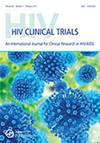Novel imaging modalities for the comparison of bone microarchitecture among HIV+ patients with and without fractures: a pilot study
Q2 Medicine
引用次数: 11
Abstract
Background: HIV-infected adults have increased fracture risk. Objectives: To generate pilot data comparing bone density, structure, and strength between HIV-infected adults with and without a prior fracture. Methods: Adults with and without a prior fracture after their HIV diagnosis were matched 1:1 based on age, sex, race, and smoking history. Participants underwent dual-energy X-ray absorptiometry (DXA), trabecular bone score (TBS), hip structural analyses (HSA), vertebral fracture assessment (VFA), high-resolution peripheral quantitative tomography (HR-pQCT) and measurement of bone turnover markers. Results were compared between cases and controls, with differences expressed as percentages of control group values. Results: 23 pairs were included. On DXA, cases had lower areal bone mineral density (aBMD) at the total hip (median difference in T-score −0.25, p = 0.04), but not the lumbar spine (median difference in T-score 0.10, p = 0.68). Cases had greater abnormalities in HSA and most HR-pQCT and HSA measures, by up to 15%. VFA revealed two subclinical fractures among cases but none among controls. TBS, CTX, and P1NP levels were similar between groups, with differences of 1.9% (p = 0.90), 9.7% (p = 0.55), and 10.0% (p = 0.24), respectively. For each parameter, we report the median and interquartile range for the absolute and relative difference between cases and controls, the correlation between cases and controls, and our recruitment rates, to inform the design of future studies. Conclusions: These pilot data suggest potential differences in bone structure, estimated bone strength, and asymptomatic vertebral fractures among HIV-infected adults with and without fracture, warranting further study as markers of fracture risk in HIV.比较HIV+患者骨折和不骨折的骨微结构的新成像方式:一项初步研究
背景:hiv感染的成年人骨折风险增加。目的:生成比较有和没有骨折史的hiv感染成人的骨密度、结构和强度的试点数据。方法:根据年龄、性别、种族和吸烟史,对HIV诊断后有和没有骨折史的成年人进行1:1匹配。参与者接受了双能x线吸收仪(DXA)、骨小梁评分(TBS)、髋部结构分析(HSA)、椎体骨折评估(VFA)、高分辨率外周定量断层扫描(HR-pQCT)和骨转换标志物测量。比较病例和对照组的结果,差异以对照组值的百分比表示。结果:共纳入23对。在DXA上,患者全髋关节的面骨矿物质密度(aBMD)较低(t评分中位数差值为- 0.25,p = 0.04),但腰椎没有(t评分中位数差值为0.10,p = 0.68)。病例在HSA和大多数HR-pQCT和HSA测量中有更大的异常,高达15%。VFA显示病例中有2例亚临床骨折,而对照组中没有。TBS、CTX和P1NP水平各组间相似,差异分别为1.9% (p = 0.90)、9.7% (p = 0.55)和10.0% (p = 0.24)。对于每个参数,我们报告了病例和对照组之间绝对和相对差异的中位数和四分位数范围、病例和对照组之间的相关性以及我们的招募率,以便为未来研究的设计提供信息。结论:这些试点数据表明,在有和没有骨折的HIV感染成人中,骨结构、估计骨强度和无症状椎体骨折存在潜在差异,值得进一步研究作为HIV感染骨折风险的标志。
本文章由计算机程序翻译,如有差异,请以英文原文为准。
求助全文
约1分钟内获得全文
求助全文
来源期刊

HIV Clinical Trials
医学-传染病学
CiteScore
1.76
自引率
0.00%
发文量
0
审稿时长
>12 weeks
期刊介绍:
HIV Clinical Trials is devoted exclusively to presenting information on the latest developments in HIV/AIDS clinical research. This journal enables readers to obtain the most up-to-date, innovative research from around the world.
 求助内容:
求助内容: 应助结果提醒方式:
应助结果提醒方式:


